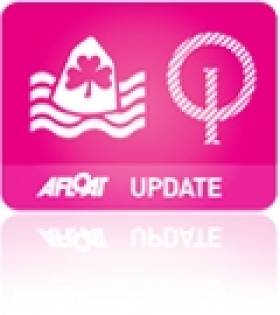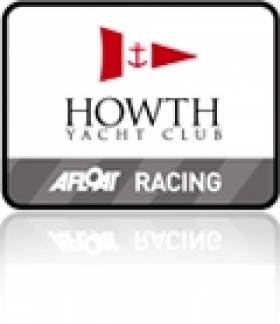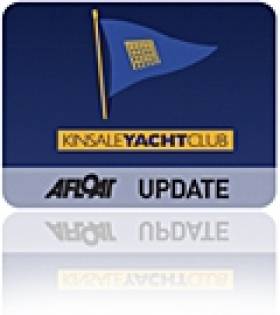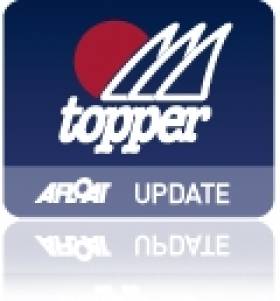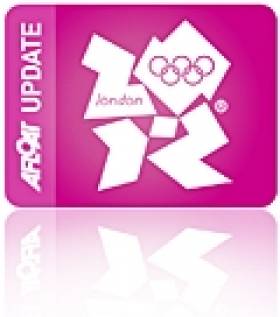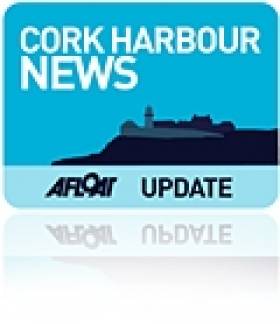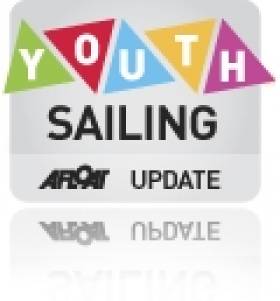Displaying items by tag: Dinghy
At the end of every season there is always speculation about who will be buying new boats and what new combinations will be sailing together the following season. The advent of a World Championships heightens that speculation and with the Fireball Worlds scheduled for June 2011 in Sligo, the Irish fleet were the beneficiaries of this fevered activity writes Cormac Bradley.
At the close of the 2010 season the word was that there would be at least one new boat coming into Ireland for 2011. Ironically, the speculation about these individuals' plans has not been resolved because they are not partcipants in the Dun Laoghaire Frostbite Series, coming as they do from the northern side of the Liffey.
Then the word was out of first one and then two new boats, both coming to Dun Laoghaire. Both have now arrived to Stephen Oram and Kenny Rumball respectively. Kenny's boat is still in dry storage (as advised as recently as last Sunday, 1oth April), but Stephen's boat has already taken to the water. Both boats will have numbers around the 15060 mark, as I have seen a photo of 15057 at the Dinghy Exhibition in London in March.
Both boats will be sailed by new combinations. Stephen Oram teamed up with Noel Butler for the Frostbite Series which they won, despite significant on the water competition from Rumball and others. However, it seems the partnership will extend into the 2011 summer season and the Worlds in June. Seamus Moore announced his (premature) retirement from Fireballs after the Barbados Worlds to go running on a serious basis and among his achievements was completing the New York marathon. However, by the time of the 2010 Fireball Nationals, in Baltimore, he was teamed up with Kenny Rumball to finish 2nd overall and they saw out the season in Dunmore East and the Munsters Championships, which they won.
In addition to being very competitive in the Frostbites, the pair were going afloat early on Sunday mornings to get more time on the water. Thus it would appear that they are an "item" for the Sligo Worlds.
Therefore, as the eve of the 2011 regatta season approaches, these two are at the leading edge of the domestic fleet. There are other more established partnerships that will also contest Sligo, Owen Laverty & Ed Butler (Snr), Frank Miller & Grattan Donnelly, Andy Boyle & Brian Flahive among others but none of these have been able to consistently knock Butler/Oram or Rumball/Moore off the winning path.
Over the winter, the most successful Irish Fireballer internationally, outside the aforementioned, in recent times, Francis Rowan, has been conspicuous by his absence. Francis, sailing with red-hot talent from the UK, Tom Gillard (2010 European Champion), was placed third at the 2009 Fireball Europeans in La Rochelle, winning one race, and was placed inside the top ten at the Worlds the following week, again winning a race. To date there isn't a whisper of Francis' 2011 plans.
The domestic season kicked off last weekend, 9/10th April, with Silver Fleet training in Killaloe, organised by Neil Colin. This weekend coming (15/16th April) we have another training weekend with Adam Bowers at the Royal St. George Yacht Club in Dun Laoghaire. Adam is the perennial coach to the British Cadet Class and has coached Olympic aspirants in the 470 Class. He is based in Weymouth, the venue for the 2012 Olympic Regatta which gives his proteges a distinct advantage in the 2012 qualification process. This will be Adam's fourth visit to these shores for training Irish Fireballers and last year's format of coaching at an active regatta, the Leinsters in Howth, was enormously successful. The first regatta of the season will follow shortly therefater, the Leinsters, hosted by Carlingford Sailing Club on the southern shores of Carlingford Lough on 7/8 May. Ex-Fireball Chairman, Ian O'Gorman is the organiser of the event in one of the country's most picturesque locations within very easy driving distance of the greater Dubln area.
Thera are no regattas planned in advance of the Worlds but there will be a reconnaisance in Sligo over the weekend of 21/22 May where we will be joined by Tim Rush of North Sails. This is a revised plan that brings together what was going to be a training weekend by Tim in Dun Laoghaire and a separate visit to Sligo. The absence of regattas is to afford people time for their own individual plans for getting up to speed for Sligo. In a separate assessment of Irish chances at the Sligo Worlds, Noel Butler speculated that two Irish combinations could get into the top 20 in Sligo. At this stage, Butler/Oram and Rumball/Moore would appear to be the leading candidates for those two slots, but the other Irish combinations will be doing their best to upset that particular "applecart" but in a friendly way!
Sailing to Success at Kinsale Optimist Trials
Fourteen year old Dun Laoghaire sailor Sean Donnelly was in top form sailing off Kinsale yesterday (SCROLL down for Photos by Bob Bateman) to win four of eight races in the first leg of the 2011 Optimist dinghy sailing trials. All races were completed to schedule. Top ten results below from IODAI.
| 1 | 1438 | Senior | Sean Donnelly | M | 14 | NYC | 10 | 1 | 2 | 2 | 1 | 1 | 2 | 1 | 6 |
| 2 | 1368 | Senior | Sophie Browne | F | 14 | TBSC/RCYC | 22.71 | 5 | 7 | 1 | 4 | 4 | 1 | 3.71 | 4 |
| 3 | 1440 | Senior | Harry Whitaker | M | 14 | RCYC | 31 | 2 | 1 | 13 | 2 | 2 | 7 | 4 | 15 |
| 4 | 1441 | Senior | Eoin Lyden | M | 14 | RCYC/BSC | 44.29 | 10 | 8 | 5 | 6 | 14 | 3 | 7.29 | 5 |
| 5 | 1439 | Senior | Peter McCann | M | 14 | RCYC | 48 | 3 | 3 | 9 | 5 | 10 | 12 | 6 | 12 |
| 6 | 1442 | Senior | Cliodhna Ni Shuilleabhain | F | 13 | KYC | 56 | 4 | 10 | 10 | 17 | 17 | 5 | 8 | 2 |
| 7 | 1433 | Senior | Jil McGinley | F | 14 | RCYC | 59 | 8 | 11 | 8 | 9 | 19 | 4 | 11 | 8 |
| 8 | 1411 | Junior | Ronan Cournane | M | 12 | RCYC/KYC | 64 | 7 | 12 | 4 | 15 | 12 | 20 | 3 | 11 |
| 9 | 1315 | Senior | Fergus Flood | M | 13 | HYC | 68 | 9 | 48 | 18 | 10 | 18 | 8 | 2 | 3 |
| 10 | 1437 | Senior | Sean WADDILOVE | M | 14 | SSC/HYC | 85 |
Howth Yacht Club Lays Out 2011 Sailing Programme
At a launch reception in the club on Thursday 31st March attended by representatives of local commerce, tourism and community bodies, HYC Commodore Roger Cagney announced that in addition to junior and adult sail training courses and club racing four days a week in the summer months, the Club would host over 20 open events during the year.
"We are used to sailing being a year-round activity," he said, "but even by our standards this will be an exceptionally busy year for Howth Yacht Club. We are fortunate in the number of talented volunteers we can call upon to help make these events successful and we have an enviable track record in this regard. We are also extremely grateful for the sponsorship of individual events from commercial concerns, details of which will be released in due course."
The major event on the 2011 calendar is undoubtedly the European Championship of the J24 Class, the world's most popular racing keelboat, when over 200 sailors from six or more countries will compete in the four-day regatta in September.
Howth will also host the Irish Championships of four classes – Puppeteer, Squib, Howth 17 and Optimist – between July 1st and late-August, with the latter attracting up to 200 competitors, together with their families, coaches and supporters. In addition, HYC will run the SB3 Eastern Championships (end April), the RS Feva Leinsters (late May) and the Dublin Match Racing Open (in J80s in early September).
The club's programme also comprises the Spring Warmer series in April, the annual Lambay Races on June 11th, the Dinghy Regatta a week later and the ever-popular Autumn League over five weekends in September/October.
Moth Dinghy Debuts on Dublin Bay
Since our report on Ireland's debut at the Moth worlds in January it was inevitable that one of these high speed sailing dinghies would appear on Irish waters soon enough. Yesterday, John Chambers took his first tack of 2011 on Dublin Bay in a Moth he bought in France. Clearly the high speed foiling craft did not go unnoticed. It got an immediate thumbs up from the nearby DMYC frostbite fleet sailing their penultimate race.
The Bladerider Moth came blasting back from the Baily lighthouse, according to eyewitness accounts. It has hydrofoils on the dagger board and rudder which lift the boat out of the water when sufficient speed is achieved.
It is Chamber's intention to sail the innovative dinghy in this Summer's Dublin Bay Sailing Club (DBSC) summer season.
Video of the Dublin Bay sail plus a photo from Bob Hobby is below:

Moth sailing on Dublin bay. Photo: Bob Hobby
Moth sailing in Ireland on facebook HERE
Thirty Enjoy Kinsale's Frostbite Finale
Conditions for the final day of the ASM-Marine Frostbite League at Kinsale Yacht Club on Sunday could not have been a more inviting finale for the thirty plus sailors competing in the Laser, Squib and Mixed Dinghy Fleets. Despite losing two of the six week series due to the weather, the last day of the season brought welcome sunshine accompanied by a fresh Force 4 North to North-Westerly breeze, gusting Force 5 at times. Three windward-leeward races were completed which brought the total race number to eleven, with two discards applying. The constantly shifting Northerly breeze, which tracked slowly westwards was the predominate feature in all three races, with an ebb tide having effect to the right hand side of the coarse.
Dara O'Shea (KYC) with another gritty performance in the Laser 4.7 fleet, managed this week to overhaul the league leader Cian Byrne (KYC/RCYC). Leaving it to the final race and with both sailors on nineteen points, Dara grasped the top spot as he fought off his rivals and eventually took line honours and the Laser 4.7 League title. Cian untypically finished fourth but nevertheless secured second place overall, just two points behind. Darragh O'Sullivan had an excellent day's racing with a win and two seconds which pulled him into third place overall, just ahead of Conor Murphy (KYC) who finished on the same points total but one place behind in the final race.
Proving once again that consistency is the key to success in the Frostbite League, Eoghan Cudmore (KYC) with a fifth, third and a second in the Radial Fleet managed to hold off the challenge for the top spot from last year's winner Sean Murphy (KYC) who scored two thirds and a fourth. With the second best results of the day, Colm O'Regan (KYC) scoring two seconds and a fourth, moved up to third place overall. Despite an excellent run of results with three wins on the final day Thomas Chaix (KYC) with insufficient points accrued could not make an impact on the final order.
In the Laser Standard Class Rob Howe (RCYC) continued his outstanding form with a further second place and two firsts bringing his overall total to an unassailable eleven points, fourteen points ahead of his nearest rival Paul O'Sullivan of Monkstown. Scoring two thirds and a second, O'Sullivan's consistent form paid off bringing him into second place overall. David Kenefick (RCYC) who had closely pursued the leader throughout the series, dropped to third place overall as he did not compete on the day.
Seldom conceding line honours Marcus Hutchinson and Ben Fusco (KYC) in the Squib Class went into the final day leading comfortably by eight points. Two wins later and a final second easily secured the league title and are now the new holders of the Bruce Mathews Squib Trophy. In a repeat of last year Paul McCarthy (KYC) finished strongly with two seconds and a win in the final race. These results elevated him from fourth place overall into the prize winning second position. Victor Fusco and Ruth Ennis (KYC) with a final third, fourth and seventh subsequently slipped one place to claim the third prize overall.
In the Mixed Dinghy Class, despite conceding line honours in all three races Brian Jones and Gary Frost (MBSC) in their International 505 finished the series as the lead boat four points comfortably ahead. The RS Feva of David Marshall and Rob Scandrett (RCYC) closed on a high note as they took advantage with three win ASM-Marine KYC Frostbite League - Sunday 27th Feb, 2011.
Conditions for the final day of the ASM-Marine Frostbite League at Kinsale Yacht Club on Sunday could not have been a more inviting finale for the thirty plus sailors competing in the Laser, Squib and Mixed Dinghy Fleets. Despite losing two of the six week series due to the weather, the last day of the season brought welcome sunshine accompanied by a fresh Force 4 North to North-Westerly breeze, gusting Force 5 at times. Three windward-leeward races were completed which brought the total race number to eleven, with two discards applying. The constantly shifting Northerly breeze, which tracked slowly westwards was the predominate feature in all three races, with an ebb tide having effect to the right hand side of the coarse.
Dara O'Shea (KYC) with another gritty performance in the Laser 4.7 fleet, managed this week to overhaul the league leader Cian Byrne (KYC/RCYC). Leaving it to the final race and with both sailors on nineteen points, Dara grasped the top spot as he fought off his rivals and eventually took line honours and the Laser 4.7 League title. Cian untypically finished fourth but nevertheless secured second place overall, just two points behind. Darragh O'Sullivan had an excellent day's racing with a win and two seconds which pulled him into third place overall, just ahead of Conor Murphy (KYC) who finished on the same points total but one place behind in the final race.
Proving once again that consistency is the key to success in the Frostbite League, Eoghan Cudmore (KYC) with a fifth, third and a second in the Radial Fleet managed to hold off the challenge for the top spot from last year's winner Sean Murphy (KYC) who scored two thirds and a fourth. With the second best results of the day, Colm O'Regan (KYC) scoring two seconds and a fourth, moved up to third place overall. Despite an excellent run of results with three wins on the final day Thomas Chaix (KYC) with insufficient points accrued could not make an impact on the final order.
In the Laser Standard Class Rob Howe (RCYC) continued his outstanding form with a further second place and two firsts bringing his overall total to an unassailable eleven points, fourteen points ahead of his nearest rival Paul O'Sullivan of Monkstown. Scoring two thirds and a second, O'Sullivan's consistent form paid off bringing him into second place overall. David Kenefick (RCYC) who had closely pursued the leader throughout the series, dropped to third place overall as he did not compete on the day.
Seldom conceding line honours Marcus Hutchinson and Ben Fusco (KYC) in the Squib Class went into the final day leading comfortably by eight points. Two wins later and a final second easily secured the league title and are now the new holders of the Bruce Mathews Squib Trophy. In a repeat of last year Paul McCarthy (KYC) finished strongly with two seconds and a win in the final race. These results elevated him from fourth place overall into the prize winning second position. Victor Fusco and Ruth Ennis (KYC) with a final third, fourth and seventh subsequently slipped one place to claim the third prize overall.
In the Mixed Dinghy Class, despite conceding line honours in all three races Brian Jones and Gary Frost (MBSC) in their International 505 finished the series as the lead boat four points comfortably ahead. The RS Feva of David Marshall and Rob Scandrett (RCYC) closed on a high note as they took advantage with three wins and claimed the second prize overall. Finishing third on the day and third overall in the series was the Feva of Fiona Lynch and Sofie Kelleher.
At the Prize Giving, Alice Kingston KYC Commodore, congratulated the deserving winners and thanked all the sailors for their efforts. Special thanks went to PRO Bruce Mathews for his dedicated support, the Organisers, the Sponsor ASM-Marine and all those who had helped both on and off the water to make this annual event such a success. Cameron Good KYC Vice-Commodore presented the prizes and June Matthews presented the Bruce Matthews Trophies for the best performances in the Laser Radial and Squib Classes won by Eoghan Cudmore and Marcus Hutchinson respectively. The inaugural Laser 4.7 'Destiny' Trophy was presented to Dara O'Shea.
- ASMMarine
- Kinsale
- yacht
- Club
- Frostbite
- Dara O'Shea
- Cian Byrne
- Darragh O'Sullivan
- Conor Murphy
- Eoghan Cudmore
- Colm O'Regan
- Sean Murphy
- Ben Fusco
- Marcus Hutchinson
- squib
- Paul McCarthy
- Ennis
- Ruth
- Dinghy
- Cameron Good
- Ruth Ennis
- Fiona Lynch
- Sofie Kelleher
- David Marshall
- Laser
- David Kenefick
- RCYC
- Royal Cork
Dun Laoghaire Set for Topper World Champs
The club is expecting a turnout of up to 300 sailors that will make it the biggest dinghy sailing event in the country this year. "We will have a large contingent from the UK and many sailors from far away – we have had interest from Korea, Japan and Hong Kong, for example". Says Margaret Margaret Kneafsey, Chairperson of the Organising Committee.
Carlow sailor Finn Lynch, 16, who is the reigning British and Irish champion finished third in the 2010 World Championships in Lake Como, Italy.
The event has its own website with details on accommodation and logistics and entries.
Annalise Murphy is Miami Medal Prospect
The strong Dun Laoghaire girl relished the prospects of the big winds that blew at times on Biscayne Bay this week. Consistent results of 5, 15, 2, 2, 5, 6 11,9, (21) and 5 never saw her out of the top five.
Tuesday saw her bag two second places in a fleet of 58. It was a turning point in a regatta that she crashed out of last year only to return wth grit to be Ireland's only medal hope today.
Last night's move up to fourth overall on the scoreboard is another confidence boost, heightening the prospect of a place on this evening's podium. Conditions in Miami today are forcast to be light, probably not the conditions the National Yacht club girl would have hoped for.
In the Star Peter O'Leary and his crew for his London 2012 bid David Burrows finished with a strong fifth place yesterday but it was not enough to make today's final. They finished 13th overall after counting a black flag disqualification on day two of the event. See all results HERE.
Rival to Annalise, Tiffany Brien from Belfast Lough finished 21st overall.
Her club mate Jame Espey was 49th out of 52 after 7 races in the Laser gold fleet.
More from Miami organisers below:
Waking to a brisk northwesterly breeze, sailors at US SAILING’s Rolex Miami OCR yesterday made up for races lost to light air Wednesday. The conditions, though chilly by Florida standards, played out perfectly for medals to be determined in three Paralympic classes, while 10 Olympic classes fought their final battles for the right to compete in tomorrow’s medal races, which are comprised of top-ten “sail-offs” for Finn, 49er, Men’s 470, Women’s 470, Laser, Laser Radial, Men’s RS:X, Women’s RS:X and Star classes, and Finals and Petit Finals for Elliott 6m (women’s match racing). The regatta, which began Monday for 716 sailors from 53 nations, prepares Olympic and Paralympic sailing aspirants for the 2012 Games and is the second of seven stops on the International Sailing Federation (ISAF) Sailing World Cup circuit.
For France’s Damien Seguin, a two-time 2.4mR IFDS World Champion who is currently ranked #1 in the world, winning gold in the Paralympic 2.4mR class was looking good from day two when he assumed the lead over his 30-boat fleet. Clinching today, however, was not as straightforward as today’s scores seemed to reflect. Following seven boat lengths behind leader USA’s John Ruf (Pewaukee, Wis.) at the finish in race one, Seguin was determined the actual winner when Ruf was disqualified for starting the race prematurely and neglecting to exonerate himself. “After that, for my next two races, my score was such that I needed only to loosely cover Thierry Schmitter (NED),” said Seguin, further explaining that only if he finished worse than sixth would he foil his own plot. Schmitter, another IFDS World Champion, took the Silver Medal, finishing fourth in the first race and winning the next two, each time with Seguin behind in second.
“There were many different winds here,” said Damien about the practice this provides for his run for a spot on the French national team. “We started in strong wind, then there was light wind and today medium-strong. I am very happy for that and for the competition.”
Taking bronze was Canada’s Allan Leibel, who is able-bodied and allowed to compete here, since the class is declared “open” for this event.
The Gold Medal taking in the Paralympic Sonar class by GBR’s John Robertson/Hannah Stodel/Steve Thomas came with an intriguing twist today. With two races completed, the Dutch team of Udo Hessels/Mischa Rossen/Marcel van de Veen were in the lead, and surprisingly, they did not sail the third and final race.
“There were two points between us and the Dutch, so no one will ever know how it would have played out on the water,” said Robertson, explaining that he understands Hessel’s middle crew Rossen, a single-arm amputee, had been having problems with his opposite shoulder and the team had decided beforehand to race no more than two races today.
Robertson’s team, which took the Silver here last year, posted a final score of 30 to the 36 points posted by silver medalists Bruon Jourdren/Eric Flageul/Nicolas Vimont Vicary (FRA). The Dutch team, with 37 points, is going home with the Bronze.
As for his team’s overall strategy here, Robertson said, “We tried to sail our own race and not get hung up with the other guys. Hanna did a fantastic job calling tactics, especially today, as the wind was up and down and all over the place, with 40-50 degree shifts.”
The Australian Paralympic SKUD 18 team of Daniel Fitzgibbon/Liesl Tesch has led their fleet since day one and boasted six victories in their nine-race score line to take the Gold medal. Today they finished 1-1-2.
“We didn’t walk away with it, really, but we were comfortably ahead,” said Fitzgibbon, who won a Paralympic Silver Medal (with a different crew) in Qingdao. "We didn’t expect to have done so well with such a new combination,” he added, noting that he and Tesch, who gave up Paralympic basketball (she is a two-time medalist) for her new-found love of sailing, have only been together on the SKUD 18 for a few weeks. “It’s a new challenge for her and a breath of fresh air for everybody.”
Taking Silver was US Sailing Team AlphaGraphics’ Scott Whitman/Julia Dorsett (USA), with Alexandra Rickham/Niki Birrell (GBR) taking the Bronze.
Medal Races Tomorrow
Top-ten finishers from today in each of nine Olympic classes will get only one chance--a 30- to 40-minute race—to make or break their claim to a podium position. Emulating the Olympic format, the medal race counts double points and cannot be counted as the one allowed discard race when it is added to a sailor’s score line from the rest of the series.
In women’s match racing, US Sailing Team AlphaGraphics members Anna Tunnicliffe(/Molly Vandemoer/Debbie Capozzi (Plantation, Fla., USA/Redwood City, Calif./Bayport, N.Y., USA) will meet Claire Leroy/ Elodie Bertrand/Marie Riou (FRA) in a first-to-three points Finals match tomorrow to determine Gold and Silver medalists. Lucy Macgregor/Mary Rook/ Kate Macgregor (GBR) and Sally Barkow (Nashotah, WI., USA)/ Alana O’Reilly (Charleston SC, USA)/ Elizabeth Kratzig-Burnham (Miami Beach FL, USA) will be fighting for bronze in the Petit Finals.
Match racing starts on its own course at 9:30 tomorrow, with fleet racing starting at 11:00 am on two additional courses. Fleet races are planned to be approximately 30 minutes in length and started 40 minutes apart. No racing will start after 1:40 p.m., so it will be an early day.
US SAILING has partnered with the city of Miami to provide world-class venues for competition. Additional hosts for the event include Coral Reef Yacht Club, Key Biscayne Yacht Club, Coconut Grove Sailing Club, Miami Rowing Club and Shake-a-Leg Miami. These sailing organizations host classes onshore, as well as help run the on-the-water racing. The Coral Reef Yacht Club also hosts the Opening and Closing Ceremonies.
In addition to title sponsor Rolex Watch U.S.A., US SAILING’s 2011 Rolex Miami OCR is also sponsored by AlphaGraphics, Gowrie Group, Chubb Insurance, Sperry Top-Sider, Harken McLube, Trinity Yachts, University of Miami Hospital and Kattack.
A complete roster of competitors can be viewed at the event website, RMOCR.ussailing.org, where real-time racecourse blogging, commentary and fan interaction, regatta results, photos and news updates will be integrated into a live coverage platform once racing begins. Video highlights produced by Gary Jobson and presented by Rolex air daily and are available on-demand on the event website. Fans can also follow the event on Facebook/RolexMiamiOCR and Twitter/RolexMiamiOCR.
More in our Olympics 2012 category HERE
O'Shea Fourth in Moth Worlds Silver Fleet
Ex-Pat Michael O'Shea has finished fourth in the silver fleet of the Moth world championships staged in Belmont, Australia.
The class promises to be the next hot thing because of its high speed through the use of foils that keep the hull clear of the water. The class has yet to be established in Ireland.
The Cork sailor set a personal best of 27.5 knots (10 second average) in one of the races.
O'Shea, a former 49er and Hobie 18 sailor from Monkstown, is now living in Sydney and was the sole Irish competitor at the Moth event.
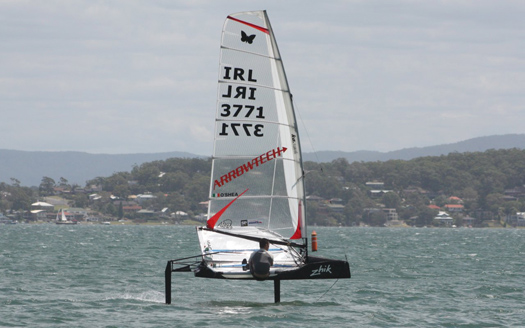
Michael has heard that heard there are a couple of boats in Dublin and is keen to help out anyone who is looking to get into the class with tips and tricks.
Watch the interview with Michael below. More pics of Michael HERE.
His next target on water is to try and hit 30 knots, not bad in a sailing dinghy! but his target ashore is to spread the word of these great advances back home.
"I'm looking to see if I can promote the class in Ireland and get some other sailors interested. The next worlds (2012) are in Lake Garda, somewhat easier to get to fro Ireland, he told Afloat.ie.
And it appears the boats are easily transportable- thanks to Ryanair - click HERE
Greagsbey in Front at Howth Laser Frostbtes
Blessington's Finn Lynch Wins British Topper Nationals
From a 15 race series the St. Mary's Carlow school boy took six first places in a fleet of over 300 boats.
The rising star of Irish junior sailing, who is already a world silver medallist in the class, beat Brtiains' Edward Jones by a margin of nine points.
In July, Lynch took control of the Irish Championships in July to count nothing but podium finishes on his way to the national title against a fleet of 66 in Carlingford.
Earlier this year Lynch also cleared up at the ISA Youth Nationals winning seven out of eleven races in Schull.
Topper Results here.



























